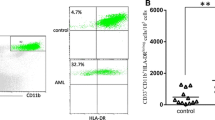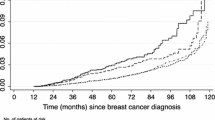Abstract
This study sought to evaluate whether myeloid-derived suppressor cells (MDSC) could be affected by chemotherapy and correlate with pathologic complete response (pCR) in breast cancer patients receiving neo-adjuvant chemotherapy. Peripheral blood levels of granulocytic (G-MDSC) and monocytic (M-MDSC) MDSC were measured by flow cytometry prior to cycle 1 and 2 of doxorubicin and cyclophosphamide and 1st and last administration of paclitaxel or paclitaxel/anti-HER2 therapy. Of 24 patients, 11, 6 and 7 patients were triple negative, HER2+ and hormone receptor+, respectively. 45.8% had pCR. Mean M-MDSC% were <1. Mean G-MDSC% and 95% confidence intervals were 0.88 (0.23–1.54), 5.07 (2.45–7.69), 9.32 (4.02–14.61) and 1.97 (0.53–3.41) at draws 1–4. The increase in G-MDSC by draw 3 was significant (p < 0.0001) in all breast cancer types. G-MDSC levels at the last draw were numerically lower in patients with pCR (1.15; 95% CI 0.14–2.16) versus patients with no pCR (2.71; 95% CI 0–5.47). There was no significant rise in G-MDSC from draw 1 to 3 in African American patients, and at draw 3 G-MDSC levels were significantly lower in African Americans versus Caucasians (p < 0.05). It was concluded that G-MDSC% increased during doxorubicin and cyclophosphamide therapy, but did not significantly differ between patients based on pathologic complete response.




Similar content being viewed by others
Abbreviations
- CALGB:
-
Cancer and Leukemia Group B
- G-CSF:
-
Granulocyte colony stimulating factor
- G-MDSC:
-
Granulocytic MDSC
- HR:
-
Hormone receptor
- IRB:
-
Institutional review board
- M-MDSC:
-
Monocytic MDSC
- MDSC:
-
Myeloid-derived suppressor cell(s)
- NAC:
-
Neo-adjuvant chemotherapy
- PBMC:
-
Peripheral blood mononuclear cell(s)
- pCR:
-
Pathologic complete response
- RCB:
-
Residual cancer burden
- TNBC:
-
Triple negative breast cancer
References
Wesolowski R, Duggan M, Stiff A et al. (2016) Abstract P4-09-18: Characterization of circulating myeloid derived suppressor cells and cytokines in patients undergoing neo-adjuvant chemotherapy for breast cancer. Cancer Res 76(4):P4-09-18. doi:10.1158/1538-7445.SABCS15-P4-09-18 (Abstract P4-09-18)
Hanahan D, Weinberg RA (2011) Hallmarks of cancer: the next generation. Cell 144:646–674
Schreiber RD, Old LJ, Smyth MJ (2011) Cancer immunoediting: integrating immunity’s roles in cancer suppression and promotion. Science 331:1565–1570. doi:10.1126/science.1203486
DeNardo DG, Brennan DJ, Rexhepaj E et al (2011) Leukocyte complexity predicts breast cancer survival and functionally regulates response to chemotherapy. Cancer Discov 1:54–67. doi:10.1158/2159-8274.CD-10-0028
Gajewski TF, Schreiber H, Fu Y-X (2013) Innate and adaptive immune cells in the tumor microenvironment. Nat Immunol 14:1014–1022. doi:10.1038/ni.2703
Markowitz J, Brooks TR, Duggan MC et al (2015) Patients with pancreatic adenocarcinoma exhibit elevated levels of myeloid-derived suppressor cells upon progression of disease. Cancer Immunol Immunother 64:149–159. doi:10.1007/s00262-014-1618-8
Wu X, Feng Q-M, Wang Y et al (2010) The immunologic aspects in advanced ovarian cancer patients treated with paclitaxel and carboplatin chemotherapy. Cancer Immunol Immunother 59:279–291. doi:10.1007/s00262-009-0749-9
Clynes RA, Towers TL, Presta LG, Ravetch JV (2000) Inhibitory Fc receptors modulate in vivo cytotoxicity against tumor targets. Nat Med 6:443–446. doi:10.1038/74704
McDonnell AM, Nowak AK, Lake RA (2011) Contribution of the immune system to the chemotherapeutic response. Semin Immunopathol 33:353–367. doi:10.1007/s00281-011-0246-z
de Biasi AR, Villena-Vargas J, Adusumilli PS (2014) Cisplatin-induced antitumor immunomodulation: a review of preclinical and clinical evidence. Clin Cancer Res 20:5384–5391. doi:10.1158/1078-0432.CCR-14-1298
Bronte V, Apolloni E, Cabrelle A et al (2000) Identification of a CD11b(+)/Gr-1(+)/CD31(+) myeloid progenitor capable of activating or suppressing CD8(+) T cells. Blood 96:3838–3846
Corzo CA, Cotter MJ, Cheng P et al (2009) Mechanism regulating reactive oxygen species in tumor-induced myeloid-derived suppressor cells. J Immunol 182:5693–5701. doi:10.4049/jimmunol.0900092
Li H, Han Y, Guo Q et al (2009) Cancer-expanded myeloid-derived suppressor cells induce anergy of NK cells through membrane-bound TGF-beta 1. J Immunol 182:240–249
Gabrilovich DI, Nagaraj S (2009) Myeloid-derived suppressor cells as regulators of the immune system. Nat Rev Immunol 9:162–174. doi:10.1038/nri2506
Bunt SK, Yang L, Sinha P et al (2007) Reduced inflammation in the tumor microenvironment delays the accumulation of myeloid-derived suppressor cells and limits tumor progression. Cancer Res 67:10019–10026. doi:10.1158/0008-5472.CAN-07-2354
Scholl SM, Pierga JY, Asselain B et al (1995) Breast tumour response to primary chemotherapy predicts local and distant control as well as survival. Eur J Cancer 31A:1969–1975
Rastogi P, Anderson SJ, Bear HD et al (2008) Preoperative chemotherapy: updates of National Surgical Adjuvant Breast and Bowel Project Protocols B-18 and B-27. J Clin Oncol 26:778–785. doi:10.1200/JCO.2007.15.0235
Baselga J, Bradbury I, Eidtmann H et al (2012) Lapatinib with trastuzumab for HER2-positive early breast cancer (NeoALTTO): a randomised, open-label, multicentre, phase 3 trial. Lancet (London, England) 379:633–640. doi:10.1016/S0140-6736(11)61847-3
Lesinski GB, Kondadasula SV, Crespin T et al (2004) Multiparametric flow cytometric analysis of inter-patient variation in STAT1 phosphorylation following interferon Alfa immunotherapy. J Natl Cancer Inst 96:1331–1342. doi:10.1093/jnci/djh252
Symmans WF, Peintinger F, Hatzis C et al (2007) Measurement of residual breast cancer burden to predict survival after neoadjuvant chemotherapy. J Clin Oncol 25:4414–4422. doi:10.1200/JCO.2007.10.6823
Mundy-Bosse BL, Young GS, Bauer T et al (2011) Distinct myeloid suppressor cell subsets correlate with plasma IL-6 and IL-10 and reduced interferon-alpha signaling in CD4+ T cells from patients with GI malignancy. Cancer Immunol Immunother 60:1269–1279. doi:10.1007/s00262-011-1029-z
Bronte V, Brandau S, Chen S-H et al (2016) Recommendations for myeloid-derived suppressor cell nomenclature and characterization standards. Nat Commun 7:12150. doi:10.1038/ncomms12150
Wesolowski R, Budd GT (2009) Neoadjuvant therapy for breast cancer: assessing treatment progress and managing poor responders. Curr Oncol Rep 11:37–44
Sikov WM, Berry DA, Perou CM et al (2015) Event-free and overall survival following neoadjuvant weekly paclitaxel and dose-dense AC ± carboplatin and/or bevacizumab in triple-negative breast cancer: outcomes from CALGB 40603 (Alliance). In: 2015 San Antonio Breast Cancer Symp. [Abstract]
Diaz-Montero CM, Salem ML, Nishimura MI et al (2009) Increased circulating myeloid-derived suppressor cells correlate with clinical cancer stage, metastatic tumor burden, and doxorubicin-cyclophosphamide chemotherapy. Cancer Immunol Immunother 58:49–59. doi:10.1007/s00262-008-0523-4
Sinha P, Clements VK, Bunt SK et al (2007) Cross-talk between myeloid-derived suppressor cells and macrophages subverts tumor immunity toward a type 2 response. J Immunol 179:977–983
Almand B, Resser JR, Lindman B et al (2000) Clinical significance of defective dendritic cell differentiation in cancer. Clin Cancer Res 6:1755–1766
Cole S, Montero A, Garret-Mayer E et al (2009) Elevated circulating myeloid derived suppressor cells (MDSC) are associated with inferior overall survival (OS) and correlate with circulating tumor cells (CTC) in patients with metastatic breast cancer. Cancer Res 69:4135. doi:10.1158/0008-5472.SABCS-09-4135 [Abstract]
Gabitass RF, Annels NE, Stocken DD et al (2011) Elevated myeloid-derived suppressor cells in pancreatic, esophageal and gastric cancer are an independent prognostic factor and are associated with significant elevation of the Th2 cytokine interleukin-13. Cancer Immunol Immunother 60:1419–1430. doi:10.1007/s00262-011-1028-0
Wesolowski R, Markowitz J, Carson WE (2013) Myeloid derived suppressor cells—a new therapeutic target in the treatment of cancer. J Immunother Cancer 1:10. doi:10.1186/2051-1426-1-10
Mandruzzato S, Solito S, Falisi E et al (2009) IL4Ralpha+ myeloid-derived suppressor cell expansion in cancer patients. J Immunol 182:6562–6568. doi:10.4049/jimmunol.0803831
Acknowledgements
This work has been supported by the National Institutes of Health Grants 2P01CA095426-11, T32 GM068412 (to M. Duggan), K12 CA 133250 as well as the Ohio State Center for Clinical and Translational Science Richard P. and Marie R. Bremer Medical Research Fund and William H. Davis Endowment for Basic Medical Research Pilot Grant (UL1TR000090).
Author information
Authors and Affiliations
Corresponding author
Ethics declarations
Conflict of interest
The authors declare no commercial or financial conflict of interest.
Electronic supplementary material
Below is the link to the electronic supplementary material.
Rights and permissions
About this article
Cite this article
Wesolowski, R., Duggan, M.C., Stiff, A. et al. Circulating myeloid-derived suppressor cells increase in patients undergoing neo-adjuvant chemotherapy for breast cancer. Cancer Immunol Immunother 66, 1437–1447 (2017). https://doi.org/10.1007/s00262-017-2038-3
Received:
Accepted:
Published:
Issue Date:
DOI: https://doi.org/10.1007/s00262-017-2038-3




